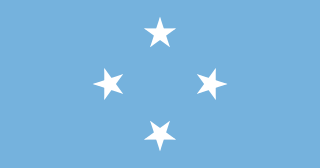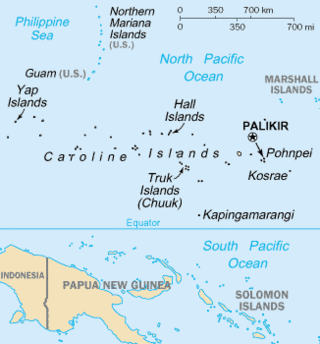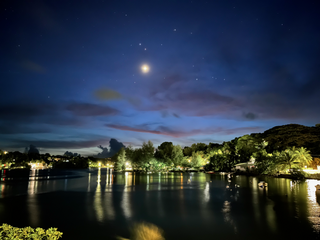Related Research Articles

The Federated States of Micronesia, or simply Micronesia, is an island country in Micronesia, a subregion of Oceania. The federation consists of four states—from west to east, Yap, Chuuk, Pohnpei and Kosrae—that are spread across the western Pacific. Together, the states comprise around 607 islands that cover a longitudinal distance of almost 2,700 km (1,700 mi) just north of the equator. They lie northeast of Indonesia and Papua New Guinea, south of Guam and the Marianas, west of Nauru and the Marshall Islands, east of Palau and the Philippines, about 2,900 km (1,800 mi) north of eastern Australia, 3,400 km (2,100 mi) southeast of Japan, and some 4,000 km (2,485 mi) southwest of the main islands of the Hawaiian Islands.

The Federated States of Micronesia are located on the Caroline Islands in the western Pacific Ocean. The history of the modern Federated States of Micronesia is one of settlement by Micronesians; colonization by Spain, Germany, and Japan; United Nations trusteeship under United States-administered Trust Territory of the Pacific Islands; and gradual independence beginning with the ratification of a sovereign constitution in 1979.

The Caroline Islands are a widely scattered archipelago of tiny islands in the western Pacific Ocean, to the north of New Guinea. Politically, they are divided between the Federated States of Micronesia (FSM) in the central and eastern parts of the group, and Palau at the extreme western end. Historically, this area was also called Nuevas Filipinas or New Philippines, because they were part of the Spanish East Indies and were governed from Manila in the Philippines.

Ulithi is an atoll in the Caroline Islands of the western Pacific Ocean, about 191 km (103 nmi) east of Yap, within Yap State.
The Micronesians or Micronesian peoples are various closely related ethnic groups native to Micronesia, a region of Oceania in the Pacific Ocean. They are a part of the Austronesian ethnolinguistic group, which has an Urheimat in Taiwan.

A rai stone, or fei stone, is one of many large artifacts that were manufactured and treasured by the native inhabitants of the Yap islands in Micronesia. They are also known as Yapese stone money or similar names.

Chuuk State is one of the four states of the Federated States of Micronesia (FSM). The other states are Kosrae State, Pohnpei State, and Yap State. It consists of several island groups: Namoneas, Faichuuk, the Hall Islands, Namonuito Atoll, Pattiw, and the Mortlock Islands. Chuuk is by far the FSM's most populous state, with 50,000 inhabitants on 120 square kilometers. Chuuk Lagoon is where most people live. Weno island, in the lagoon, is Chuuk's state capital and the country's biggest city. It may hold a referendum on independence in the near future, although this referendum has been repeatedly postponed.

The State of Yap is one of the four states of the Federated States of Micronesia, located in the westernmost portion of the country. The state borders Palau to the southwest, Guam to the north, and Chuuk State to the east. According to the state's population census carried out in 2020, the total population is 11,577 residing across a total area of 119.54 sq km, though a large majority of the area is water. The only town area in the state, Colonia, serves as the state capital.

Colonia is an urban area between the municipalities of Rull and Weloy which serves as the capital of Yap State, one of the states in the Federated States of Micronesia. It’s not to be confused with Kolonia, the capital of Pohnpei State. It administers both Yap proper and some 13 atolls and islands reaching to the east and south for some 800 kilometers.

The Catholic Church arrived in the Kingdom of Kongo shortly after the first Portuguese explorers reached its shores in 1483. Portuguese left several of their own number and kidnapped a group of Kongo including at least one nobleman, Kala ka Mfusu, taking them to Portugal where they stayed a year, learned Portuguese and were converted to Christianity. The group was returned to Kongo in 1485 and Kala ka Mfusu led a royal mission from Kongo's manikongo, Nzinga a Nkuwu to Portugal. Following their arrival in late 1486 the embassy stayed nearly four years in Lisbon with the monks of Saint John the Baptist. There they studied Christianity and Portuguese with Vicente dos Anjos, and began the start of a Kongolese version of Christianity.

The Catholic Church in Palau is part of the worldwide Catholic Church, under the spiritual leadership of the Pope in Rome. According to the last census (2000) 41.6% of the population belonged to the Catholic Church. Palau belongs to the Diocese of Caroline Islands, which is itself a suffragan to the Archdiocese of Agaña (Guam).
Micronesian Americans are Americans who are descended from people of the Federated States of Micronesia. According to the 2020 US Census, a total of 21,596 residents self-identified as having origins in the country, which consists of four states. More than half of these residents identified their origin as Chuuk State (12,464) with the rest as follows: 4,918 people from Pohnpei, 2,066 from Yap, and 2,148 people from Kosrae.

Christianity has been the main religion in the Marshall Islands ever since it was introduced by European missionaries in the 19th century.

Christianity is the predominant religion in the Federated States of Micronesia and represents an integral part of the nation's identity.

Yap traditionally refers to an island group located in the Caroline Islands of the western Pacific Ocean, a part of Yap State. The name "Yap" in recent years has come to also refer to the state within the Federated States of Micronesia, inclusive of the Yap Main Islands and its various outer islands, the Yap Neighboring Islands. For specifying the island group, the name Yap Main Islands is most exact.

The Yapese people are a Micronesian ethnic group native to the main island of Yap. Yapese culture is built on the maxim: Respect and Responsibility. Aspects of traditional Yapese culture are still important in modern Yapese culture.

A menstruation hut is a place of seclusion or isolation used by certain cultures with strong menstrual taboos. The same or a similar structure may be used for childbirth and postpartum confinement, based on beliefs around ritual impurity. These huts are usually built near the family home, have small doors, and are often dilapidated, with poor sanitation and ventilation, and no windows. The Nepali version, the Chhaupadi, is probably the best-known example, but cultural attitudes towards menstruation around the world mean that these huts exist, or existed until recently, in other places as well. The use of menstrual huts continues to be a cause of death, from exposure, dehydration, snake bite, smoke inhalation, and so on. The use of these huts is illegal in some places.

The Church of Jesus Christ of Latter-day Saints in the Federated States of Micronesia refers to the Church of Jesus Christ of Latter-day Saints and its members in the Federated States of Micronesia (FSM). The church's first known missionaries arrived on July 5, 1978. As of December 31, 2022, there were 5,966 members in 23 congregations in FSM. The LDS Church has congregations in every state in the FSM.

The Church of Jesus Christ of Latter-day Saints in the Mariana Islands refers to the organization and its members in the Mariana Islands. The Mariana Islands consist of two jurisdictions of the United States: the Commonwealth of the Northern Mariana Islands and, at the southern end of the chain, the territory of Guam. As of December 31, 2022, the LDS Church reported 2,547 members in one stake, five congregations, one mission, and one temple in Guam. There are 906 members in a ward in the Northern Mariana Islands. There are two family history centers, one in Guam and one at the Saipan Ward building in the Northern Mariana Islands.
The traditional councils of the Yap State are two assemblies of traditional leaders: the Pilung Council for the chiefs of the Yap Islands and the Tamol Council for the chiefs of the Outer Yap Islands. They have been established in 1992 by the Constitution of the Yap State, within the Federated States of Micronesia. The executive, the legislative, the judiciary and the traditional councils are the four institutional branches of government in the Yap State, but the councils, unlike the others, transcend the concept of the separation of powers. The councils are responsible for exercising the functions that relate to tradition and custom, which are not required to be recorded in the written law. In the Yap State, custom and tradition prevail over any interpretation of the constitution and even over any judicial decision. The councils have the right to veto legislation that they consider to be contrary to traditional practices. The constitutionality of these councils and their veto power could be challenged under the Micronesian Federal Constitutional Law, but to this date no one has done it.
References
- 1 2 3 4 5 6 7 8 9 10 Dobbin, Jay (2011). Summoning the Powers Beyond: Traditional Religions in Micronesia. Honolulu, HI: University of Hawaiʻi Press. ISBN 9780824832032.
- 1 2 Lingenfelter, Sherwood G. (October 1977). "Emic Structure and Decision-Making in Yap". Ethnology. 16 (4): 331–352. doi:10.2307/3773261. JSTOR 3773261.
- ↑ Pollock, Nancy J. (1992). These Roots Remain: Food Habits in Islands of the Central and Eastern Pacific Since Western Contact. Laie, Hawai'i: Institute for Polynesien Studies. pp. 35–37. ISBN 093915451X.
- ↑ Lingenfelter, Sherwood Galen (1975). Yap: Political Leadership and Culture Change in an Island Society . Honolulu: University Press of Hawaii. ISBN 0824803019.
- ↑ "Yap - Religion and expressive culture" . Retrieved October 2, 2016.
- 1 2 3 Yap State Census Report: 2000 FSM Census of Population and Housing (PDF). Government of the Federated States of Micronesia. December 2002. pp. 53–55.
- 1 2 3 4 5 Hezel, Francis X. (2003). "The Catholic Church Yap". Micronesian Seminar. Retrieved August 25, 2016.
- 1 2 3 4 Garrett, John (1997). Where Nets Were Cast: Christianity in Oceania since World War II. Suva, Fiji: Institute of Pacific Studies, University of the South Pacific. ISBN 982-02-0121-7.
- ↑ Fanning, Win. "Modern Missionary Subject of Special". Pittsburgh Post-Gazette. Retrieved September 10, 2016– via Google News Archive.
- ↑ Estabillo, Matthew T. (December 7, 2003). "Man on a Mission". The Philippine Star. Retrieved September 10, 2016.
- ↑ "Micronesia". Global Mormonism Project. Brigham Young University. Retrieved August 26, 2016.
- ↑ "Micronesia — Facts and Statistics". Mormon Newsroom. Retrieved August 25, 2016.
- ↑ Church Almanac 2013. Deseret Book. 2012. p. 524. ISBN 9781609074203.
- ↑ Oliver, Ansel (November 18, 2009). "Adventist student missionary murdered in Yap, Micronesia". Seventh-day Adventist Church. Retrieved August 30, 2016.
- ↑ "Adventist student missionary murdered in Yap, Micronesia". Adventist News Network. November 18, 2009. Retrieved March 16, 2018.